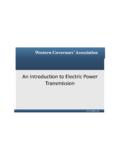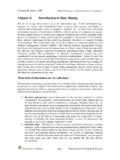Transcription of Introduction to English Linguistics - School of English
1 Introduction to English Linguistics A Companion to the Seminar (Revised and Abridged). L szl Varga E tv s Lor nd University Budapest 2010. 2. Preface The seminar called Introduction to English Linguistics is offered in English to first year students in weekly sessions. Since for most students this seminar is the only place where the topics of the course are discussed in English , teachers of this seminar often have to explain the material to their students before (or instead of!) doing exercises or discussing problems, and so a considerable part of precious seminar time is wasted on lecturing. The present book offers a solution. It contains ten units: each discusses an important topic in English and each is followed by exercises.
2 Thus it provides ample seminar material for about 12 weeks. Some of the units may be curtailed or even omitted at the teacher's discretion. The units should be assigned for home study before the actual seminar session at which they will be discussed. Thus the students will have an opportunity to get acquainted with the main ideas and the special English vocabulary of each topic before coming to the seminar, and this frees their tutors from having to lecture during the seminar, enabling them to concentrate on discussion and practical problem-solving activities. I hope both students and teachers of the Introduction to English Linguistics seminar will find this book a useful companion to the course.
3 If for any topic further reading is required, I recommend the relevant chapters of Fromkin, V. & R. Rodman (1998) An Introduction to Language. 6th ed. (Fort Worth, etc.: Harcourt Brace College Publishers), or Radford, A., M. Atkinson, D. Britain, H. Clahsen & A. Spencer (1999) Linguistics , An Introduction . (Cambridge: CUP). August 2010. L szl Varga E tv s Lor nd University Budapest 3. Acknowledgements The contents of this book have been derived from a number of sources. The sources include standard introductory textbooks, such as Aitchison, J. (1978). Linguistics . 3rd ed. (Teach Yourself Books. Hodder & Stoughton), Akmajian, A., R. A. Demers & R. M. Harnish (1979) Linguistics : An Introduction to Language and Communication.
4 (Cambridge, Mass., London, England: The MIT Press), Fromkin, V. & R. Rodman (1998) An Introduction to Language. 6th ed. (Fort Worth, etc.: Harcourt Brace College Publishers), or Radford, A., M. Atkinson, D. Britain, H. Clahsen & A. Spencer (1999) Linguistics , An Introduction . (Cambridge: CUP), but also textbooks of more specific kinds, such as Lyons, J. (1977) Semantics. Cambridge: CUP, or Cook, V. J. & M. Newson (1996) Chomsky's Universal Grammar. 2nd ed. (Oxford: Blackwell), and many more. I would like to express my indebtedness to the authors of all of them. My thanks are also due to my colleagues d m N dasdy and P ter A. L z r, both of E tv s Lor nd University, for their expert opinions on the manuscript of this book.
5 Needless to say, I alone am responsible for any weaknesses that may have remained. L szl Varga 4. Table of Contents Preface 3. Acknowledgements 4. Table of Contents 5. Unit 1 Language 8. Communication and signs 8. linguistic communication: the use of language 9. The discrete nature of language 12. Paralanguage 16. Exercises, problems, and other tasks 17. Unit 2 The Study of Language (i) 19. Language: Externalised and Internalised 19. Components of language 19. Linguistics and its branches 20. Traditional Grammar 23. Comparative Philology 23. The Beginnings of Modern Linguistics in Europe, Saussure 24. The Beginnings of Modern Linguistics in America. the Sapir Whorf hypothesis 25.
6 Exercises, problems, and other tasks 27. Unit 3 The Study of Language (ii) 30. The Great Synthesis of American Structuralist Linguistics 31. Generative Linguistics 32. Exercises, problems, and other tasks 36. Unit 4 Phonetics and Phonology, the Study of Sounds and Phonemes 38. Phonetics 38. The tasks of phonetics 38. Phonology 43. Exercises, problems, and other tasks 46. Unit 5 Morphology, the Study of Morphemes and Words 48. Words 48. Morphemes 49. Segmentability of words into morphemes 52. Word formation 52. Exercises, problems, and other tasks 54. 5. Unit 6 Syntax, the Study of the Structure of Phrases and Sentences 56. Sentences and phrases 56. Representation 56.
7 Simple and complex sentences 58. Compound (coordinated) sentences 61. Sentence and utterance 64. Exercises, problems, and other tasks 65. Unit 7 Semantics, the Study of Meaning 68. Kinds of meaning 68. Approaches to word meaning 69. Sentence meaning 70. Sense relations between words 71. The cognitive meaning of sentences 73. Exercises, problems, and other tasks 75. Unit 8 Pragmatics, the Study of Language Use in Particular Situations 77. Pragmatics 77. The role of context and presuppositions 77. Language functions and speech acts 78. Conversational implicatures 81. Exercises, problems, and other tasks 82. Unit 9 Language Variation 84. The identity and variability of language 84.
8 User-related variation: dialect, sociolect, pidgin, creole, child language, gender differences 85. Use-related variation: spoken and written varieties, styles, registers 87. Idiolect, code switching, diglossia 88. Exercises, problems, and other tasks 89. Unit 10 Language Change 91. Periods in the history of English 91. Examples of changes 93. Exercises, problems, and other tasks 97. Appendix A: IPA symbols for the phonemes of Standard British English 98. Appendix B: The Indo-European family of languages 99. 6. 7. Unit 1. Language Communication and signs This book is an Introduction to language and Linguistics . Since language can be described as the most effective means of human communication, we will first briefly examine what we mean by communication.
9 Communication in general can be defined as the transmission of information (= transfer of a message) between a source and a receiver by means of signs. A sign is something physical, which represents something other than Signs have an exponent, a meaning and a set of referents. The exponent of a sign is its physical manifestation, something which can be perceived (heard, seen, touched, etc.) by the receiver of the message; a gesture, a facial expression, a picture, a roadsign, the sounding of a horn, a word, the smell of burning, etc. The individual things, qualities, actions, states in the world to which a sign refers are the referents (= denotata) of the sign, and these together constitute the reference (= extension) of the sign.
10 In addition to having an exponent and reference, a sign is also associated with meaning. The meaning of a sign is the concept which it evokes in its users and which can be identified with a set of semantic features; this set can be called the sign's intension. For instance, the English word girl evokes a concept that includes the features young, female, human'. The signs used in a communication system constitute a code. Signs can be divided into three basic kinds: they can be symbolic, iconic and symptomatic. When the exponent of a sign bears an arbitrary relationship to the sign's referents, the sign is a symbol. For instance, the colours used in traffic lights are symbolic: it is a matter of arbitrary convention that the red light means stop' and the green light means go', in principle it could be the other way around.














